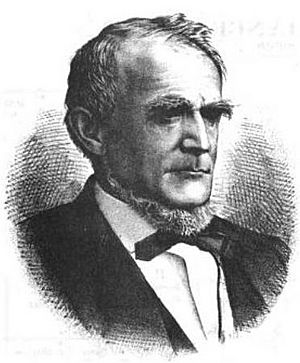George Smith (Missouri politician) facts for kids
Quick facts for kids
George Smith
|
|
|---|---|

From 1876's An Illustrated Historical Atlas of Clinton County, Missouri
|
|
| United States Marshal for the Western District of Missouri | |
| In office 1869–1877 |
|
| Preceded by | Thomas Bates Wallace |
| Succeeded by | Charles C. Allen |
| Lieutenant Governor of Missouri | |
| In office 1865–1869 |
|
| Governor | Thomas Clement Fletcher |
| Preceded by | Willard Preble Hall |
| Succeeded by | Edwin Obed Stanard |
| Member of the Missouri House of Representatives from Caldwell County | |
| In office 1862–1863 |
|
| In office 1852–1853 |
|
| Member of the Ohio House of Representatives from Columbiana County | |
| In office 1837–1839 |
|
| Personal details | |
| Born | February 2, 1809 Columbiana County, Ohio |
| Died | July 14, 1881 (aged 72) Cameron, Missouri |
| Resting place | Packard Cemetery, Cameron, Missouri |
| Political party | Democratic (before 1861) Unconditional Union (1861-1862) Republican (from 1862) |
| Spouses | Sarah A. Chapman (m. 1833-1836, her death) Mary A. Kerrins (m. 1839-1881, his death) |
| Children | 7 |
| Education | Miami University (attended) |
| Occupation | Businessman Farmer |
George Smith (born February 2, 1809 – died July 14, 1881) was an important American politician. He worked in both Ohio and Missouri. He is best known for being the Lieutenant Governor of Missouri from 1865 to 1869. He also served as a U.S. Marshal for western Missouri from 1869 to 1877.
Contents
Early Life and Education
George Smith was born in Columbiana County, Ohio on February 2, 1809. His parents were John and Mary Smith. Both of his grandfathers fought in the American Revolution. His father was a soldier in the War of 1812.
Smith went to school in Columbiana County. He also attended Miami University in Oxford, Ohio. He left college early to start his own business and farming career. He used to transport flour by boat to New Orleans. He also drove cattle from Ohio to places like Pennsylvania and Maryland. Smith was also a captain in the state militia.
Starting His Political Career
In 1835, Smith moved to East Liverpool, Ohio. There, he started a successful business as a merchant. He also worked as a freight forwarder, helping to move goods.
Smith was a member of the Democratic Party. From 1837 to 1839, he represented Columbiana County in the Ohio House of Representatives. This is where laws are made for the state of Ohio. During his time there, he led the committee that focused on banks and businesses.
Moving to Missouri
In 1832, Smith visited St. Louis, Missouri. He bought a horse and explored the western part of the state. In 1844, Smith decided to move to Caldwell County, Missouri. He lived there for 24 years.
He brought a group of sheep from Ohio to his new home. He became one of the first big wool farmers in Missouri.
In 1852, Smith was elected to the Missouri House of Representatives. He helped pass a bill that created two important railroads: the Hannibal and St. Joseph Railroad and the Pacific Railroad. During the Bleeding Kansas crisis in the 1850s, Smith was against slavery. He strongly supported keeping the United States together.
Role During the Civil War
When the American Civil War began, George Smith was a strong supporter of the Union. He was also an abolitionist, meaning he wanted to end slavery. He helped organize a local army group in Caldwell County to support the Union. This was one of the first such groups outside of St. Louis.
In 1862, he was elected to the Missouri House of Representatives again. He was part of the Republican group that planned a meeting for Union supporters in Missouri. This meeting led to important changes. It helped to end slavery in Missouri. It also limited voting rights to only those who supported the Union and opposed the Confederacy.
In 1864, Smith became the president of the state Republican meeting. This meeting was held in Jefferson City. The people at the meeting chose Smith to run for lieutenant governor. He won the election by a large number of votes. He served as Lieutenant Governor from January 2, 1865, to January 12, 1869.
As Lieutenant Governor, Smith led the meetings of the Missouri Senate. Both Republicans and Democrats praised him for being fair. He also led the state board that handled property tax assessments.
Later Life and Legacy
In 1868, Smith moved to Cameron, Missouri. In March 1869, he was appointed United States Marshal for the Western District of Missouri. A U.S. Marshal is a federal law enforcement officer. He served in this role until March 1877. He then decided to retire.
In his retirement, Smith was very active in the Presbyterian church in Cameron. He was a ruling elder there for several years.
George Smith passed away in Cameron on July 14, 1881. He was buried at Packard Cemetery in Cameron.
Family Life
In 1833, George Smith married Sarah A. Chapman. She was from Brooke County, West Virginia. They had one son and one daughter together. Sarah Chapman Smith died in 1836.
In 1839, Smith married Mary A. Kerrins. With his second wife, he had three sons and two daughters.

